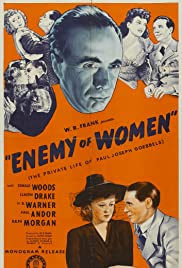
ENEMY OF WOMEN
US, 1944, 72 minutes, Black-and-white.
Claudia Drake, Paul Andor, Donald Woods, H.B.Warner, Sigrid Gurie, Ralph Morgan, Gloria Stuart, Robert Barrat.
Directed by Alfred Zeisler.
An unexpected title for a 1944 American war propaganda film, targeting the Nazi regime but, especially, Joseph Goebbels, the portrait of him part actual, part fiction. His played by the American actor Paul Andor – and, in many sequences, there is an uncanny resemblance.
The American film industry produced a number of propaganda films during the early 1940s, targeting Hitler, criticism of the Master Race, films critical of Heydrich. This one is of interest because it was produced and released before the Battle of the Bulge, 1944 – 1945.
The film introduces Goebbels in the 1920s, something of a loner, trying to write plays, coaching the daughter of the landlord in Romeo and Juliet and making an advance on her which she not only rejects but laughs at him. The next sequence is of him going to listen to a speech by Hitler, hearing the Hitler tones but the focus on his face, becoming ever more devoted and fanatic in his loyalty to Hitler, inaugurating the Heil Hitler. The film then shows him becoming more powerful as Hitler rises in power, becomes Chancellor, the burning of the Reichstag… He also assumes responsibility for propaganda and the arts, especially films, and invites the young woman from the past to do a screen test and become a film star. While she achieves some fame and status, she still resists him and he cuts her off.
The actress is played by Claudia Drake. She encounters a pleasant doctor, played by Donald Woods, and, eventually, marries him and, as the war breaks out, they live in Vienna. Her father is played by H.B.Warner, a veteran from World War I. He is assassinated.
There are quite some complications as the war proceeds, the young woman getting a visa to return to Berlin from Vienna, her wanting a visa for her husband. Once again, she is in the power of Goebbels who continues to be more ruthless, making a bargain with her that her husband can escape into Switzerland, thinking that she will accompany him but she is to be detained at the border and returned to Berlin.
Rather a sad ending, but this is 1944. However, at the end, there are defiant claims that the thousand year Reich will not last many years at all and that Nazis and Goebbels will be defeated. In fact, Goebbels was dead within a year of the release of the film.
A curiosity item worth looking at to gauge some of the mentality of 1944 – and then looking at it in the hindsight of the Nazi regime and World War II.